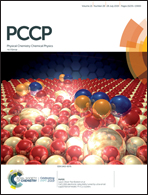Disparate strain response of the thermal transport properties of bilayer penta-graphene as compared to that of monolayer penta-graphene†
Abstract
In this study, strain modulation of the lattice thermal conductivity of monolayer and bilayer penta-graphene (PG) at room temperature was investigated using first-principles calculations combined with the phonon Boltzmann transport equation. The thermal conductivities of both the monolayer and the bilayer PG exhibit a robust nonmonotonic up-and-down behavior under strain despite the effect of van der Waals (vdW) interactions, and the thermal conductivities of bilayer PG under strain are significantly reduced by up to 87%. Using phonon-level systematic analysis, the variation of thermal conductivity with the increasing strain was determined by increasing the phonon lifetime in specific phonon modes, and that with the reduction of strain was determined by the decrease of both phonon group velocity and phonon lifetime. Moreover, bilayer PG shows an unexpectedly different response to strain when compared with monolayer PG, and a significantly larger reduction (>60%) in the thermal conductivity of bilayer PG is achieved when the strain reaches 10% because the interlayer interactions enhance the phonon anharmonicity of the phonon modes of ultra-low frequency. Our study shows that bilayer PG will have tremendous opportunities for application in thermal management and two-dimensional nanoscale electronic devices owing to its largely tunable thermal conductivity.



 Please wait while we load your content...
Please wait while we load your content...